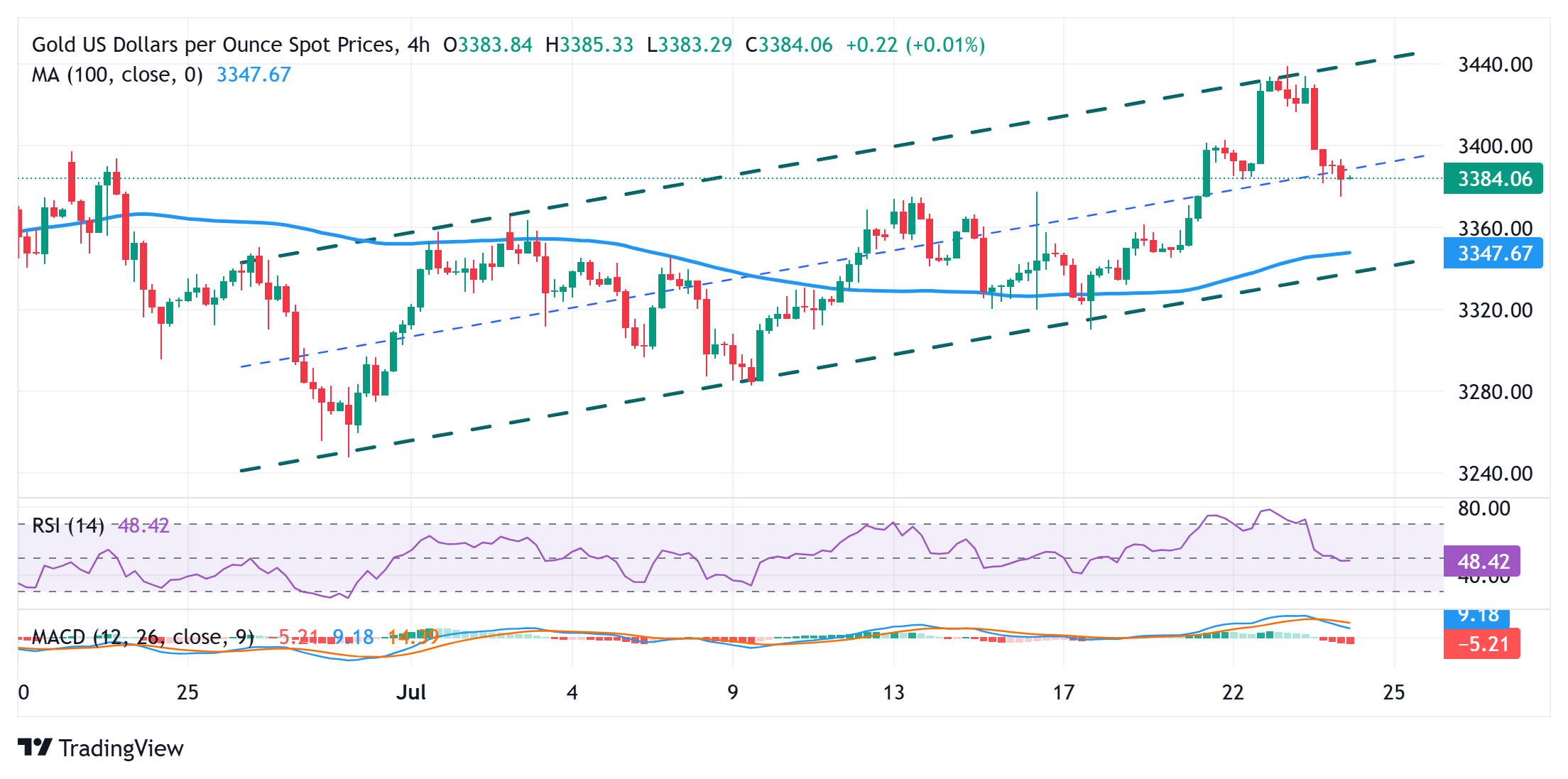Gold price remains depressed below $3,400 amid trade optimism; downside seems limited
- Gold price attracts some follow-through selling as trade optimism undermines safe-haven demand.
- The Fed rate-cut uncertainty keeps the USD bulls on the defensive and could support the commodity.
- Traders now look to the release of flash global PMIs and the US macro data for a short-term impetus.
Gold price (XAU/USD) remains on the defensive during the Asian session on Thursday and looks to extend the previous day's sharp retracement slide from its highest level since June 16. Reports that the US and the European Union (EU) are closing in on a tariff deal add to the optimism led by the US-Japan trade agreement. This remains supportive of the upbeat market mood and turns out to be a key factor undermining demand for the safe-haven bullion.
However, a combination of factors could act as a tailwind for the Gold price and limit deeper losses. Investors remain uncertain about the likely timing and the pace of interest rate cuts by the Federal Reserve (Fed). Adding to this, fears that the central bank's independence could be under threat from mounting political interference keep the US Dollar (USD) depressed near a two-week low and could offer support to the non-yielding yellow metal.
Daily Digest Market Movers: Gold price is pressured by receding safe-haven demand on trade optimism
- US President Donald Trump announced late Tuesday that his administration had reached a trade deal with Japan. Furthermore, reports that the US and the European Union are heading towards a 15% trade deal boost investors' confidence and weigh on the safe-haven Gold price for the second straight day on Thursday.
- The markets do not expect an interest rate cut from the US Federal Reserve in July despite Trump's continuous push for lower borrowing costs. In fact, Trump has been attacking Fed Chair Jerome Powell personally over his stance on holding rates and repeatedly calling for the central bank chief's resignation.
- Moreover, Fed Governor Chris Waller and Trump appointee Vice Chair for Supervision Michelle Bowman have advocated a rate reduction as soon as the next policy meeting on July 30. This keeps the US Dollar depressed near a two-and-a-half-week low and could offer some support to the non-yielding yellow metal.
- Traders now look forward to the release of flash PMIs, which would provide a fresh insight into the global economic health and influence the safe-haven commodity. Apart from this, the crucial European Central Bank policy decision might infuse some volatility in the markets and drive the XAU/USD pair.
- Meanwhile, the US economic docket features Weekly Initial Jobless Claims and New Home Sales data, which, in turn, would drive the USD and contribute to producing short-term trading opportunities around the commodity. Nevertheless, the fundamental backdrop warrants caution for aggressive traders.
Gold price bulls have the upper hand amid the formation of a short-term ascending trend-channel

From a technical perspective, the recent move up along an upward sloping channel since the beginning of this month points to a well-established short-term uptrend. Adding to this, positive oscillators on the daily chart suggest that the Gold price is more likely to find decent support near the $3,370-3,368 strong horizontal resistance breakpoint. A convincing break below the said area, however, could expose the lower end of the trend-channel, currently pegged near the $3,333-3,332 region. The latter should act as a key pivotal point, which if broken decisively might shift the near-term bias in favor of the XAU/USD bears.
On the flip side, momentum back above the $3,400 mark could pause near the $3,438-3,440 static barrier. This coincides with the trend-channel resistance, above which the Gold price could accelerate the positive move towards challenging the all-time peak, around the $3,500 psychological mark touched in April.
Tariffs FAQs
Tariffs are customs duties levied on certain merchandise imports or a category of products. Tariffs are designed to help local producers and manufacturers be more competitive in the market by providing a price advantage over similar goods that can be imported. Tariffs are widely used as tools of protectionism, along with trade barriers and import quotas.
Although tariffs and taxes both generate government revenue to fund public goods and services, they have several distinctions. Tariffs are prepaid at the port of entry, while taxes are paid at the time of purchase. Taxes are imposed on individual taxpayers and businesses, while tariffs are paid by importers.
There are two schools of thought among economists regarding the usage of tariffs. While some argue that tariffs are necessary to protect domestic industries and address trade imbalances, others see them as a harmful tool that could potentially drive prices higher over the long term and lead to a damaging trade war by encouraging tit-for-tat tariffs.
During the run-up to the presidential election in November 2024, Donald Trump made it clear that he intends to use tariffs to support the US economy and American producers. In 2024, Mexico, China and Canada accounted for 42% of total US imports. In this period, Mexico stood out as the top exporter with $466.6 billion, according to the US Census Bureau. Hence, Trump wants to focus on these three nations when imposing tariffs. He also plans to use the revenue generated through tariffs to lower personal income taxes.

